A large box containing a sous vide supreme demi arrived at my door yesterday. It felt a little like Christmas, except with $1000 kitchen toys to test-drive instead of ugly sweaters. That being said, the idea of flavourful food vacuum-sealed then cooked long and slow made me giddier than a sugar plum-induced high ever could. Visions of succulent steak, tender chicken breast and custard-like eggs danced through my head.
It was SousVide Supreme – a company launched in 2009 by two nutrition expert doctors – that first created a bread maker-sized home version of the immersion circulator and a countertop vacuum sealer. This is what arrived at my door – the modern microwave.
Right now, dropping the words “sous vide” at a dinner party comes with a certain food snob cachet. $369 for the sous vide supreme demi plus $160 for a vacuum sealer and starter pack of plastic bags, is an investment. But Maxime Bilet, a Forbes 2011 Food & Wine “Thirty Under Thirty” and former head chef of the venture capital-funded Modernist Cuisine Cooking Lab in Bellevue, Washington, predicts that as prices continue to drop, the systems will start appearing on kitchen counters next to blenders and toaster ovens.
Sous vide cooking is a large part of the “modernist cuisine” movement championed by Ferran Adría, the chef of the famed but now closed three Michelin starred Spanish restaurant, El Bulli. It has now become a style that pretty much defines the contemporary restaurant movement internationally and is often lumped together with other modernist equipment including G-Force centrifuges and siphons – tricks and tools that create anything from foams, powders and gels to DIY-pop rocks, and that have over the past few years banished the culinary ennui of stuffy fine-dining establishments.
But sous vide cooking has more long-term potential than some of these other gadgets of the modernist movement. It’s small, energy-efficient, and it’s essentially just modern slow-cooking. From Moroccan tajines in flour-sealed pots to Julia Child’s braised boeuf bourguignon, slow-cooking has been practiced the world over for centuries. The sous vide machine employs the same “long and low” technique, resulting in tender food that’s hard to overcook. But instead of using a pot, you seal your ingredients in food-grade plastic then place it in an immersion circulator of water heated to and retained at a specific temperature. Bacteria have trouble surviving the oxygen-starved vacuum, so sealing, like storing duck legs in duck fat (confit), allows food to be cooked hours or days in advance. And a new movement of health-conscious sous vide “haute cuisine” features lean cuts of meat cooked until miraculously tender without excess fat and vegetables that retain more nutrients than when boiled or steamed.
But if this machine becomes a standard appliance it does more than make delicious food – it makes delicious food easy to make. Beginner brunch line-cooks can create hollandaised masterpieces for hundreds of hungover hipsters. And supposedly even you or I could make three Michelin star-quality food.
———————————————————————————————————–
Day 1: 64.5˚ C Egg
My first impulse upon receiving the Sous Vide Supreme Demi is to assure Justin, the accommodating sales rep of Cedarlane Culinary, the Canadian distributor of the SousVide Supreme Demi, that I wouldn’t hesitate to call him, 24 hours a day, should I run into problems.
The question is: could I justify calling him at 2am to ask how to vacuum seal bison tenderloin in food-grade plastic? Fortunately for Justin, I decide to start with the easiest sous vide recipe – a soft-boiled egg – since there’s no vacuum sealing involved.
The girlfriend of Forbes A-lister, Bilet, cried the first time he cooked her 64.5˚C eggs, so I’m going with that temperature. Now I just need 32 cups of water to fill the machine, and a way to kill time because the ideal cooking time for a 64.5˚ egg is between 45 minutes and 2 hours. With sous vide machines the cooking window is relatively large and most foods are difficult to overcook. A 176˚F roast is ready in anywhere between one and four hours, and Keller’s short ribs cook for up to 3 days. So, machine filled and plugged in, I switch the temperature setting to Fahrenheit since it won’t allow me to set it to half-degrees in Celcius. I click the up-arrow to the equivalent 148˚ F, press start, and wait for the machine to preheat.
Should it beep when it’s ready? I check back ten minutes later but the light that’s supposed to turn green is insisting on staying red. I reset the temperature to 148˚F, and frown when the screen flashes back to 123˚F. Frantic, I think of Justin, but finally notice the temperature rise to 123.1. I’m relieved, but disappointed by the hypocrisy of the machine that preheats in tenths while not letting me set half-degrees.
Nowhere in the manual does it say how to lower an egg in its shell into the preheated water. Metal tongs? I close my eyes and hope to not be electrocuted. I must have failed high school chemistry. I will not tell Justin this. He will take away my toy.
After about 50 minutes (the manual says to not bother setting the timer – a bold instruction to anxious cooks) I lift the just-warm egg from the water and knock it gently against the side of my plate of saffron rice with cinnamon, almonds and asparagus (50 minutes is a long time in which to get creative). Though it seems raw – the white still translucent – I think of Bilet’s girlfriend’s tears and decide not to nuke the plate to be sure the egg is safe to eat. Instead, I break the yolk over the pilaf and watch as thick yellow ribbons slowly envelope the rice.
What a perfect egg. A little fancy salt and the whole thing becomes a delicate, creamy sauce for the rice. This is an egg-lover’s dream come true. I wish I loved eggs.
I think about how I could have cooked a dozen or more eggs at the same time, and how they would all taste just as wonderfully custardy. I think about calling Justin – who has probably marveled at this already – to share my excitement. But no matter how creamy and awe-inspiring, making a single egg and tossing out 32 cups of water (the manual insists you not leave it in the machine) after 1 hour of simmering seems wasteful, even if I didn’t have to vacuum-seal it in polycarbon. And though the machine would accommodate a dozen or more in a single batch, there’s no way I could eat them all by myself within a few days.
When I have 15 children and live on a farm where I need to make eggs every morning for my strapping lads before sending them out into the fields, I will buy a sous vide machine. I will be the queen of benedicts. The egg McMuffin master. The high commander of hollandaise.
The Sous Vide Supreme Demi instruction manual, however, does not say to have 15 children. The manual and I agree.
————————————————————————————————————
Day 2: Duck Breast and Bison Steak Three Ways
Sous vide cooking is reputed to render inexpensive, lean steaks and expensive duck breast alike so tender that neither cleavers nor stubborn determination are necessary to eat them. To test this I choose a duck breast and three different cuts of bison (they are better quality, leaner, and cheaper than cow at my local market, but beef also works): an inexpensive bavette, a fatty, expensive T-Bone, and a faux filet that falls somewhere in-between. Cooking any of these in a pan or on a grill for too long or at too high a temperature results in tough outer meat paired with either overcooked or still-bloody insides. If the cooking time is too short or the cooking temperature too low for the duck breast, however, I will end up with layers of gelatinous, undercooked fat.
For my first vacuum-sealing dish I follow the recipe book that accompanies the sous vide machine and place each steak or duck breast in its own bag with salt, pepper and nothing more. I put the end of the plastic bag in the vacuum sealer, lower the top, and press “vacuum seal.” Any idiot could do it.
Any idiot but me. The machine makes a lot of noise, but 30 seconds later the bag is still open. I’ve never vacuum-sealed before but I don’t think it’s this long a process. I press cancel, and after debating waking poor Justin, I turn to the internet instead.
The online manual says I’m supposed to close the lid until I hear two clicks. So I put some force into it. If the internet says there should be a “click, click,” then I’m going to press until it “click, clicks.” I jump for added downward force, and finally, it clicks on the right side. I jump again and click the left side. Weak and elderly people are hereby cut from the “who can cook sous vide” list. I, too, am almost cut by natural selection.
This vacuum sealing is much more fun than normal vacuuming. I feel strangely satisfied as air leaves my seasoned T-Bone and a thin line of heat melts the two sides of the plastic bag together. “Unclick, unclick,” and I transfer the bag to the removable rack in the preheated 140F water, which the manual says is the correct temperature for medium-rare.
My three steaks and one duck breast, however, won’t fit in the machine. The bags came with the machine, thus they should fit in the removable rack that separates them and allows water to surround them. Instead they’re peeking out of the water, which the manual says is bad. It also says the bags should not rest directly on the bottom of the machine. So I remove the rack and place the duck flat on the bottom grill, which allows water to circulate below, and stack the steaks on top of each other below the water line. This ignores the “no touching” rule, but I probably won’t get salmonella.
Isn’t the point of sous vide cooking to not use a stove? I wonder as I prepare to sear the cooked duck breast (as instructed). Not according to the machine’s box, which lists stovetop searing as the third step of sous vide cooking (“simmer” and “seal” being the other two catchy verbs). Though searing technically has nothing to do with being “under vacuum,” I happily watch the fat melt into a luscious meat bath as I brown the duck and steaks briefly on each side.
The seared outer edge is thin and crisp while the interior meat is consistently medium-rare. My bavette is also exquisite. My T-Bone and faux filet are a little overcooked, but next time I’ll cook them less and they will be my version of perfect, I think as I pour the liquefied duck fat from the searing into my sweet and sour rhubarb sauce for the meat.
But wait…what happens if you need to make both a medium-rare and a medium-well steak simultaneously? To each his or her own, but if two people differ on the ideal steak temperature, how could they live happily cooking sous vide? One would always be hungry, having to wait an extra 80 minutes for supper, as the machine can’t be set to two temperatures. Lesser problems have ended relationships.
In the future when sous vide cooking is ubiquitous, people will ask each other their preferred meat temperature on first dates. This will prevent heartache and is another practical side of sous vide cooking – like having 15 children who all like their eggs and meat at the same temperature.
————————————————————————————————————
After a month of cooking with the sous vide machine I learned that broccoli is the most disgusting thing you will ever cook at 85 C; sous vide chicken is almost good enough to justify books with titles such as “365 Things to Do With Leftover Lean Chicken Breast”; and although Masterchef alumnus, Sharone Hakman, effortlessly seals strawberries, champagne and sugar in the DVD that accompanies the machine, when I try I end up with a soaked vacuum sealer and an unsealed bag. Fortunately, I found something better to do with the Champagne.
Stoves, microwaves, and toaster ovens aren’t going anywhere yet, but sous vide machines are fun for gadget-loving cooks. I am also swayed by delicious sous vide bison, duck, and chicken breast, though not quite convinced the sous vide investment is worth it for my medium-rare-loving family of one. But if I can be an excellent cook with a sous vide machine, anyone can. And if you need help “click-click-ing” I am sure Justin would be happy to do so.
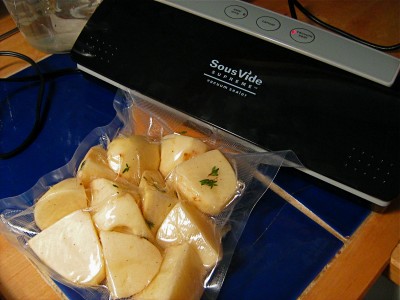
*http://www.edinformatics.com/math_science/science_of_cooking/eggs_sous_vide.htm
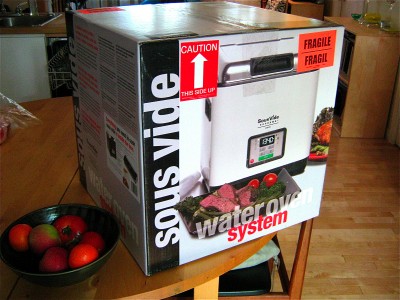
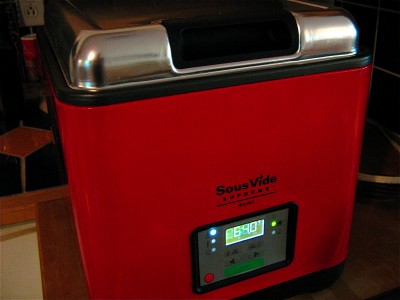
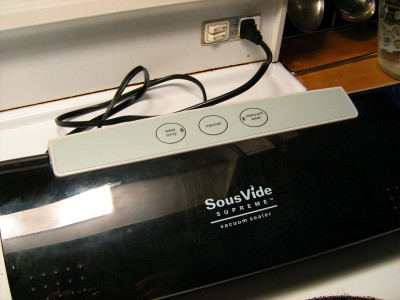
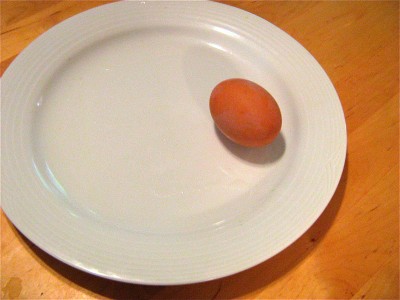
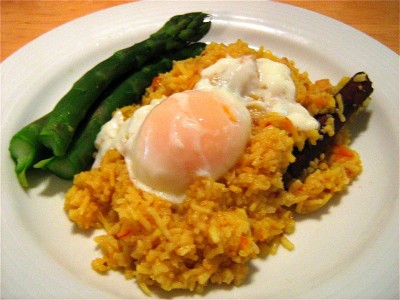

Leave a Reply